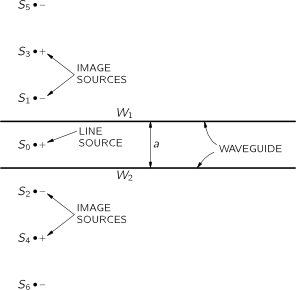I was reading The Feynman Lectures on Physics, Volume II, when I got to the section on waveguides. Toward the end, Feynman uses the concept of an infinite number of alternating line sources to explain attenuation and propagation in the guide.
While I very much enjoyed this point of view, one problem did stick out in my mind. If we have an infinite number of sources, I agree the beam will zero out everywhere except at the special angles for which all sources constructively interfere (far from the sources). However, at this angle, wouldn't an infinite number of positively reinforcing waves produce an infinite field? Do the further sources produce weaker fields, making the sum finite?
Even if that's true, what if we consider the problem in terms of bouncing plane waves? Won't the transverse field components be infinite in extent and constant down the guide, setting up a standing wave pattern. But, since in an infinitely long guide there will be infinite in-phase reflections, shouldn't the resulting fields be infinite?
When we mathematically solve for the fields however, they seem to turn out perfectly finite, even in ideal conductors.
Where's the discrepancy? Any help would be greatly appreciated!

